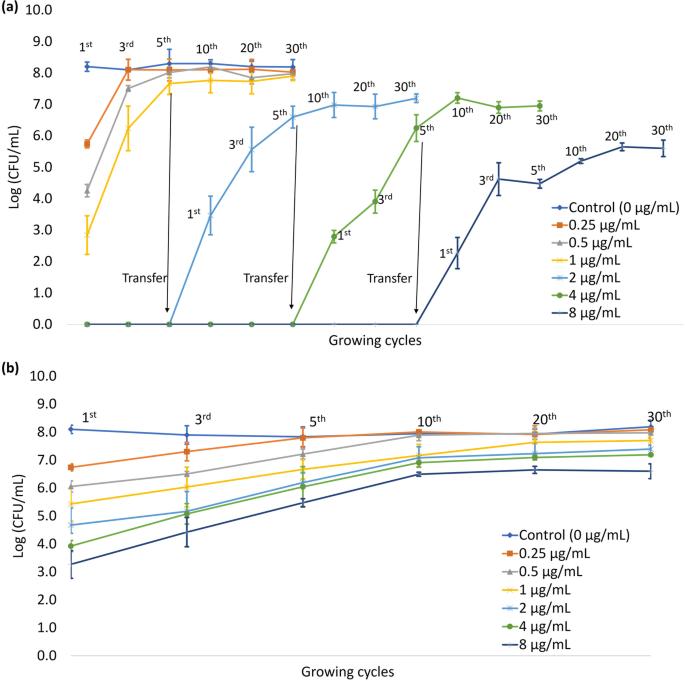细胞形态作为接触碳青霉烯类的生物标志物。
IF 2.7
4区 医学
Q3 BIOTECHNOLOGY & APPLIED MICROBIOLOGY
引用次数: 0
摘要
鉴定细菌细胞对抗生素的生理反应对于设计诊断技术、选择治疗方法和开发药物至关重要。虽然细菌细胞在亚致死剂量抗生素作用下的特征已被普遍描述,但长期连续接触高浓度抗生素对细菌的影响及其对停药的影响仍需关注,以进一步确定其特征。本研究调查了增加亚胺培南浓度对碳青霉烯类敏感(S)和碳青霉烯类耐药(R)大肠杆菌的生长适应性和细胞表面结构的影响。我们将细菌群暴露在亚胺培南浓度不断增加的环境中,共进行了 30 次暴露循环。使用三维激光扫描共聚焦显微镜(LSCM)和透射电子显微镜(TEM)观察了细胞形态。结果表明,暴露会导致大肠杆菌(S)细胞形态发生显著变化,而大肠杆菌(R)细胞则变化较小。棒状的大肠杆菌(S)逐渐转变为圆形。此外,暴露的大肠杆菌(S)细胞的表面积与体积比(SA/V)也与对照组(即未暴露的大肠杆菌(S))有显著差异。然后,将暴露的大肠杆菌(S)细胞在无抗生素环境中重新生长 100 个生长周期,以确定细胞的变化是否可逆。结果显示,它们的细胞形态仍然是圆形的,这表明细胞形态的变化是不可逆的。这些细胞对亚胺培南的形态反应有助于在诊断和抗菌疗法中了解抗药性机制。本文章由计算机程序翻译,如有差异,请以英文原文为准。


Cell morphology as biomarker of carbapenem exposure
Characterizing the physiological response of bacterial cells to antibiotics is crucial for designing diagnostic techniques, treatment choices, and drug development. While bacterial cells at sublethal doses of antibiotics are commonly characterized, the impact of exposure to high concentrations of antibiotics on bacteria after long-term serial exposure and their effect on withdrawal need attention for further characterization. This study investigated the effect of increasing imipenem concentrations on carbapenem-susceptible (S) and carbapenem-resistant (R) E. coli on their growth adaptation and cell surface structure. We exposed the bacterial population to increasing imipenem concentrations through 30 exposure cycles. Cell morphology was observed using a 3D laser scanning confocal microscope (LSCM) and transmission electron microscope (TEM). Results showed that the exposure resulted in significant morphological changes in E. coli (S) cells, while minor changes were seen in E. coli (R) cells. The rod-shaped E. coli (S) gradually transformed into round shapes. Further, the exposed E. coli (S) cells’ surface area-to-volume ratio (SA/V) was also significantly different from the control, which is non-exposed E. coli (S). Then, the exposed E. coli (S) cells were re-grown in antibiotic-free environment for 100 growth cycles to determine if the changes in cells were reversible. The results showed that their cell morphology remained round, showing that the cell morphology was not reversible. The morphological response of these cells to imipenem can assist in understanding the resistance mechanism in the context of diagnostics and antibacterial therapies.
求助全文
通过发布文献求助,成功后即可免费获取论文全文。
去求助
来源期刊

Journal of Antibiotics
医学-免疫学
CiteScore
6.60
自引率
3.00%
发文量
87
审稿时长
1 months
期刊介绍:
The Journal of Antibiotics seeks to promote research on antibiotics and related types of biologically active substances and publishes Articles, Review Articles, Brief Communication, Correspondence and other specially commissioned reports. The Journal of Antibiotics accepts papers on biochemical, chemical, microbiological and pharmacological studies. However, studies regarding human therapy do not fall under the journal’s scope. Contributions regarding recently discovered antibiotics and biologically active microbial products are particularly encouraged. Topics of particular interest within the journal''s scope include, but are not limited to, those listed below:
Discovery of new antibiotics and related types of biologically active substances
Production, isolation, characterization, structural elucidation, chemical synthesis and derivatization, biological activities, mechanisms of action, and structure-activity relationships of antibiotics and related types of biologically active substances
Biosynthesis, bioconversion, taxonomy and genetic studies on producing microorganisms, as well as improvement of production of antibiotics and related types of biologically active substances
Novel physical, chemical, biochemical, microbiological or pharmacological methods for detection, assay, determination, structural elucidation and evaluation of antibiotics and related types of biologically active substances
Newly found properties, mechanisms of action and resistance-development of antibiotics and related types of biologically active substances.
 求助内容:
求助内容: 应助结果提醒方式:
应助结果提醒方式:


